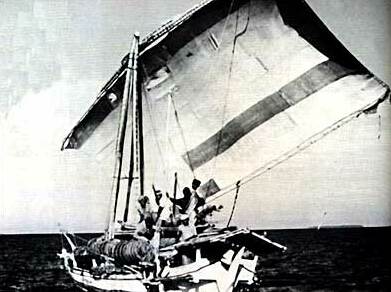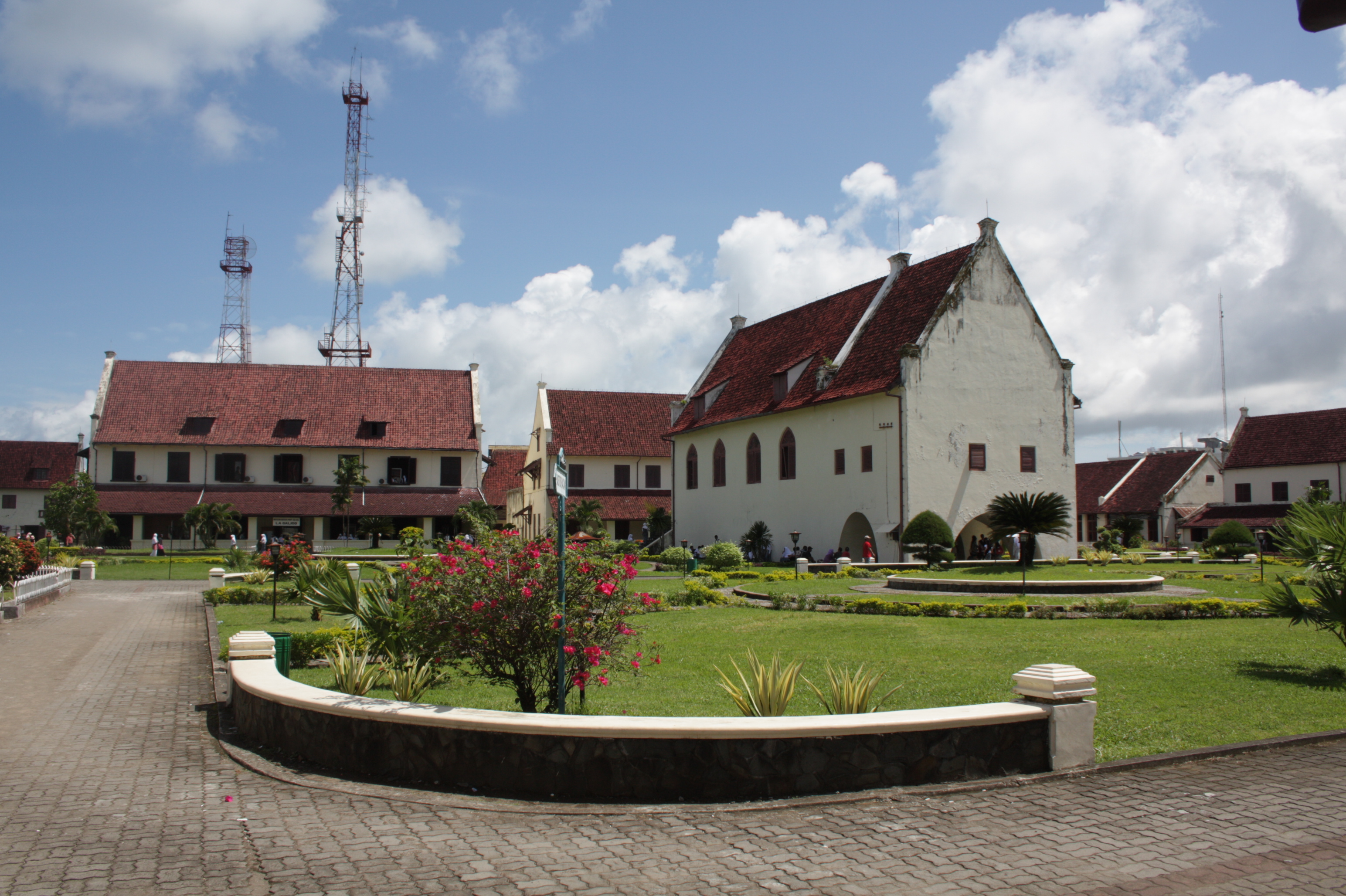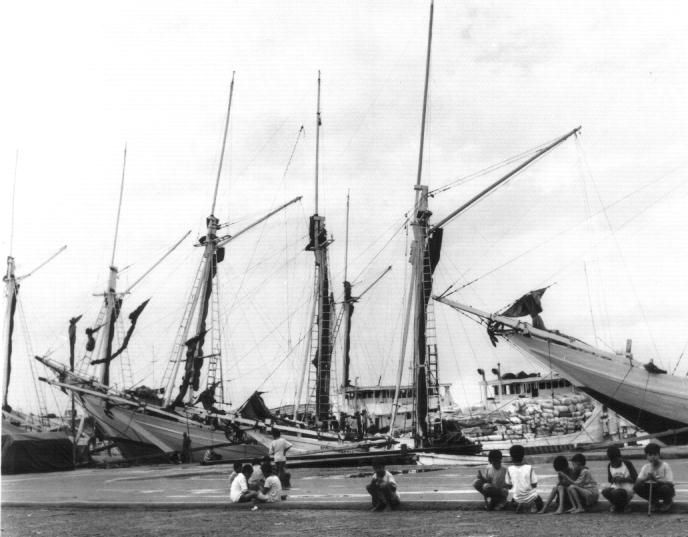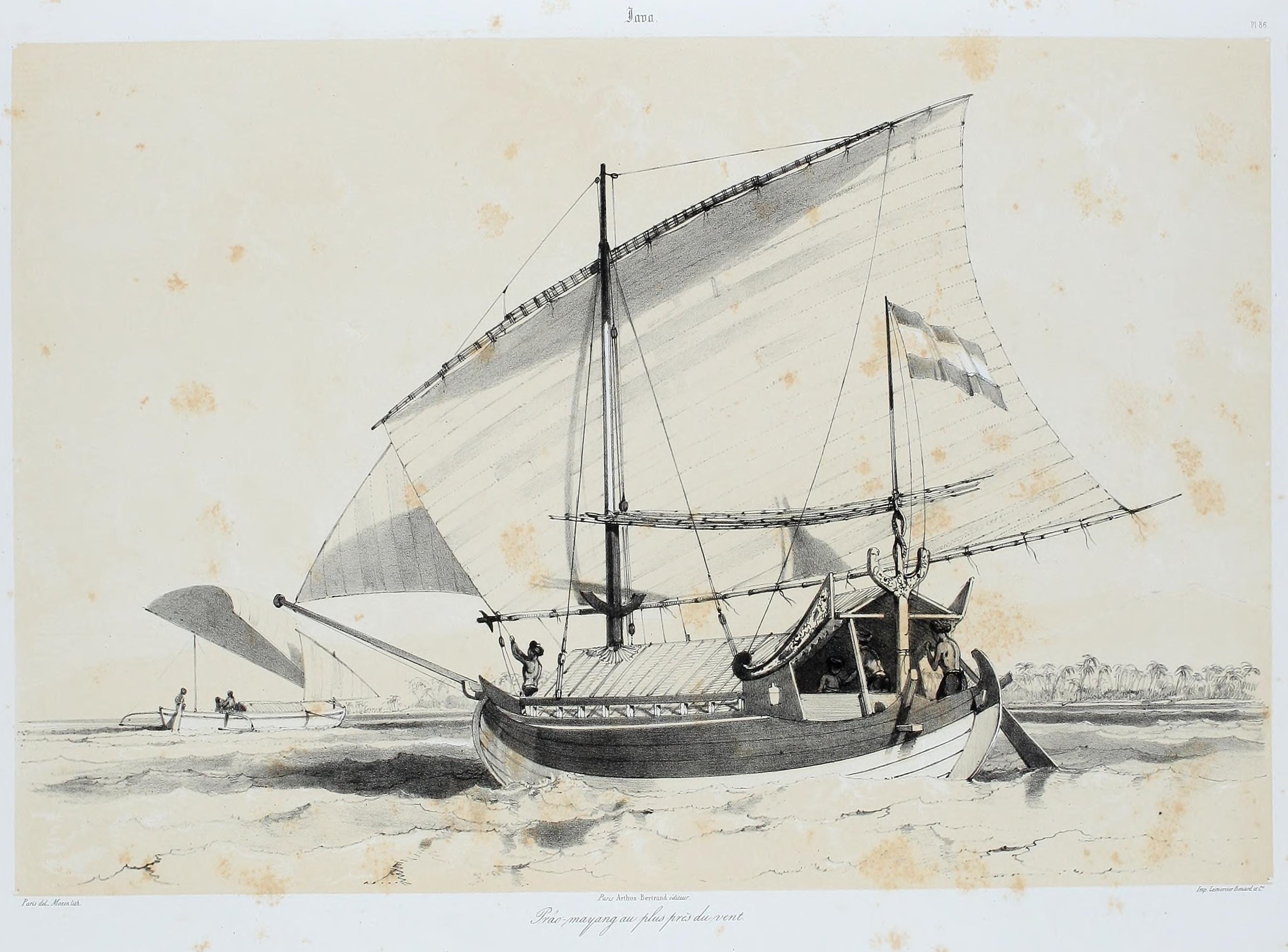|
Patorani
Patorani (also prauw patorani or perahu patorani) is a traditional fishing boat from Makassar, Indonesia. It is used by Macassan people for fishing, transport, and trading since at least 17th century A.D. Historically this type of boat was used by Gowa Sultanate as war boat. Etymology The name "torani" means flying fish (Exocoetidae).Horridge (2015). p.17 Patorani can be translated as "flying fish catcher". Description Patorani fishing boat has pajala type hull with Makassar-styled rudder mounting and tripod mast. The second tripod mast is supported by the roof of its deckhouse. This boat carried wood poles as a material for fishing and basket-shaped fish traps. The sail is usually canted rectangular sail or lateen sail. Some of them had bowsprit, adorned with pieces of wool, pendants, wooden fish carving, and other decorations. If the bowsprit is not present, they are placed in the curved stempost. Patorani design remains largely unchanged for several hundred years, but someti ... [...More Info...] [...Related Items...] OR: [Wikipedia] [Google] [Baidu] |
Indonesian Inventions
This list of Indonesian inventions and discoveries details the indigenous arts and techniques, cultural inventions, scientific discoveries and contributions of the people of Indonesian archipelago — both ancient and modern state of Indonesia. As a developing nation, currently Indonesia suffers a shortage of scientific personnel and engineers. The lack of research and development, also hampers Indonesia's comparative competitiveness. Nevertheless, despite the shortcomings, its people and government continues their efforts to advance the nation's science and technology sectors. Among other things, by promoting innovation and technology through Indonesia Science Day. Since ancient times, native Indonesians has accumulated knowledge and developed technology stemmed from necessities; from naval navigation knowledge, traditional shipbuilding technology, textile techniques, food processing to vernacular house building. Notable examples include jong, pinisi, perahu, Borobudur ship a ... [...More Info...] [...Related Items...] OR: [Wikipedia] [Google] [Baidu] |
Tanja Sail
Tanja sail (Malay language, Malay: ''layar tanjak'') or tanja rig is a type of sail commonly used by the Austronesian peoples, Austronesian people, particularly in Maritime Southeast Asia. It is also known as the tilted square sail, canted rectangular sail, rectangular balance lug, or Lug sail#Types, balance lug sail in English.Needham, Joseph (1971). ''Science and Civilisation in China: Volume 4, Physics and Physical Technology, Part III: Civil Engineering and Nautics''. Cambridge: Cambridge University Press. In historical sources, tanja sail is sometimes incorrectly referred to as Lateen Sail, lateen sail or simply square sail. Etymology Also called tanjaq, tanjak, tanja', tanjong, or tanjung sail. The Mandar people call it ''sombal tanjaq'' because when the wind blows the lower part of the sail (''peloang'') would "''mattanjaq''" (lit. "kick"). In colonial British records, it is sometimes written as "lyre ''tanjong''", a misspelling of ''layar tanjong'' (''layar'' means "sail" ... [...More Info...] [...Related Items...] OR: [Wikipedia] [Google] [Baidu] |
Trepanging
Trepanging is the act of collection or harvesting of sea cucumbers, known in Indonesian as ''trepang'', Malay těripang, and used as food. The collector, or fisher, of ''trepang'' is a trepanger. Trepanging is comparable to clamming, crabbing, lobstering, musseling, shrimping and other forms of "fishing" whose goal is the acquisition of edible invertebrates rather than fish. History To supply the markets of Southern China, Makassarese trepangers traded with the Aboriginal Australians of Arnhem Land from at least the 18th century or likely prior. This Makassan contact with Australia is the first recorded example of interaction between the inhabitants of the Australian continent and their Asian neighbours. This contact had a major impact on the Indigenous Australians. The Makassarese exchanged goods such as cloth, tobacco, knives, rice and alcohol for the right to trepang coastal waters and employ local labour. Makassar pidgin became a ''lingua franca'' along the north ... [...More Info...] [...Related Items...] OR: [Wikipedia] [Google] [Baidu] |
Makassan Contact With Australia
Makassar people from the region of Sulawesi in Indonesia began visiting the coast of northern Australia sometime around the middle of the 18th century, first in the Kimberley region, and some decades later in Arnhem Land. They were men who collected and processed ''trepang'' (also known as sea cucumber), a marine invertebrate prized for its culinary value generally and for its supposed medicinal properties in Chinese markets. The term Makassan (or Macassan) is generally used to apply to all the trepangers who came to Australia. Fishing and processing of trepang The creature and the food product are commonly known in English as sea cucumber, ''bêche-de-mer'' in French, '' gamat'' in Malay, while Makassarese has 12 terms covering 16 different species. One of the Makassar terms, for trepang, ''taripaŋ'', entered the Aboriginal languages of the Cobourg Peninsula, as ''tharriba'' in Marrku, as ''jarripang'' in Mawng or otherwise as ''darriba.'' ''Trepang'' live on the s ... [...More Info...] [...Related Items...] OR: [Wikipedia] [Google] [Baidu] |
Macassan Prau
Makassar (, mak, ᨆᨀᨔᨑ, Mangkasara’, ) is the capital of the Indonesian province of South Sulawesi. It is the largest city in the region of Eastern Indonesia and the country's fifth-largest urban center after Jakarta, Surabaya, Medan, and Bandung.Ministry of Internal AffairsRegistration Book for Area Code and Data of 2013/ref> The city is located on the southwest coast of the island of Sulawesi, facing the Makassar Strait. Throughout its history, Makassar has been an important trading port, hosting the center of the Gowa Sultanate and a Portuguese naval base before its conquest by the Dutch East India Company in the 17th century. It remained an important port in the Dutch East Indies, serving Eastern Indonesian regions with Makassarese fishers going as far south as the Australian coast. For a brief period after Indonesian independence, Makassar became the capital of the State of East Indonesia, during which an uprising occurred. The city's area is , and it ... [...More Info...] [...Related Items...] OR: [Wikipedia] [Google] [Baidu] |
Padewakang
Padewakang were traditional boats used by the Bugis, Mandar, and Makassar people, Makassar people of South Sulawesi. Padewakang were used for long distance voyages serving the south Sulawesi kingdoms. Etymology No-one quite seems to know the origin of the name ''padewakang,'' though some have suggested that it stems from Dewakang Island, an important navigational landmark between Sulawesi and Java. Dutch records from the 1735 mention letters from Sulawesi arriving in Batavia ‘per praauw Paduackang’. According to Horridge, the words ''padewakang'', ''paduwakang'' (Sulawesi) and ''paduwang'' (Madura Island, Madura) have its roots from word ''wa'', ''wangka'', ''waga'', ''wangga'', and ''bangka'' of Austronesian languages. The term is associated with outrigger perahu or small perahu. Description It typically weights between 20 and 50 tons, had one or two tripod masts with "lateen" (tanja sail, tanja) sails made of mat. Like other traditional vessels of the archipelago, it i ... [...More Info...] [...Related Items...] OR: [Wikipedia] [Google] [Baidu] |
Military Boats
A military, also known collectively as armed forces, is a heavily armed, highly organized force primarily intended for warfare. It is typically authorized and maintained by a sovereign state, with its members identifiable by their distinct military uniform. It may consist of one or more military branches such as an army, navy, air force, space force, marines, or coast guard. The main task of the military is usually defined as defence of the state and its interests against external armed threats. In broad usage, the terms ''armed forces'' and ''military'' are often treated as synonymous, although in technical usage a distinction is sometimes made in which a country's armed forces may include both its military and other paramilitary forces. There are various forms of irregular military forces, not belonging to a recognized state; though they share many attributes with regular military forces, they are less often referred to as simply ''military''. A nation's military may ... [...More Info...] [...Related Items...] OR: [Wikipedia] [Google] [Baidu] |
Types Of Fishing Vessels
Type may refer to: Science and technology Computing * Typing, producing text via a keyboard, typewriter, etc. * Data type, collection of values used for computations. * File type * TYPE (DOS command), a command to display contents of a file. * Type (Unix), a command in POSIX shells that gives information about commands. * Type safety, the extent to which a programming language discourages or prevents type errors. * Type system, defines a programming language's response to data types. Mathematics * Type (model theory) * Type theory, basis for the study of type systems * Arity or type, the number of operands a function takes * Type, any proposition or set in the intuitionistic type theory * Type, of an entire function#Order and type, entire function ** Exponential type Biology * Type (biology), which fixes a scientific name to a taxon * Dog type, categorization by use or function of domestic dogs Lettering * Type is a design concept for lettering used in typography which helped br ... [...More Info...] [...Related Items...] OR: [Wikipedia] [Google] [Baidu] |
Sailboat Types
A sailboat or sailing boat is a boat propelled partly or entirely by sails and is smaller than a sailing ship. Distinctions in what constitutes a sailing boat and ship vary by region and maritime culture. Types Although sailboat terminology has varied across history, many terms have specific meanings in the context of modern yachting. A great number of sailboat-types may be distinguished by size, hull configuration, keel type, purpose, number and configuration of masts, and sail plan. Popular monohull designs include: Cutter The cutter is similar to a sloop with a single mast and mainsail, but generally carries the mast further aft to allow for a jib and staysail to be attached to the head stay and inner forestay, respectively. Once a common racing configuration, today it gives versatility to cruising boats, especially in allowing a small staysail to be flown from the inner stay in high winds. Catboat A catboat has a single mast mounted far forward and does not ca ... [...More Info...] [...Related Items...] OR: [Wikipedia] [Google] [Baidu] |
Sailboats
A sailboat or sailing boat is a boat propelled partly or entirely by sails and is smaller than a sailing ship. Distinctions in what constitutes a sailing boat and ship vary by region and maritime culture. Types Although sailboat terminology has varied across history, many terms have specific meanings in the context of modern yachting. A great number of sailboat-types may be distinguished by size, hull configuration, keel type, purpose, number and configuration of masts, and sail plan. Popular monohull designs include: Cutter The cutter is similar to a sloop with a single mast and mainsail, but generally carries the mast further aft to allow for a jib and staysail to be attached to the head stay and inner forestay, respectively. Once a common racing configuration, today it gives versatility to cruising boats, especially in allowing a small staysail to be flown from the inner stay in high winds. Catboat A catboat has a single mast mounted far forward and does not ca ... [...More Info...] [...Related Items...] OR: [Wikipedia] [Google] [Baidu] |
Pinisi
Literally, the word pinisi refers to a type of rigging (the configuration of masts, sails and ropes (‘lines’)) of Indonesian Sailing ship, sailing vessels. A pinisi carries seven to eight sails on two masts, arranged like a gaff-ketch with what is called 'standing gaffs' — i.e., unlike most Western ships using such a rig, the two main sails are not opened by raising the spars they are attached to, but the sails are 'pulled out' like curtains along the gaffs which are fixed at around the centre of the masts. As is the case with many Indonesia sailing craft, the word 'pinisi' thus names only a type of rig, and does not describe the shape of the hull of a vessel that uses such sails. Pinisi-rigged ships were mainly built by the Konjo-speaking people of Ara, a village in the district of Bontobahari, Bulukumba regency, South Sulawesi, and widely used by Bugis, Buginese and Makassarese seafarers as a cargo vessel. In the years before the eventual disappearance of wind-powered tr ... [...More Info...] [...Related Items...] OR: [Wikipedia] [Google] [Baidu] |
Pencalang
Pencalang is a traditional merchant ship from Nusantara. Historically it was called as pantchiallang or pantjalang. It was originally built by Malay people from the area of Riau and the Malay Peninsula, but has been copied by Javanese shipwrights.Liebner, Horst H. (2016). ''Beberapa Catatan Akan Sejarah Pembuatan Perahu Dan Pelayaran Nusantara''. Jakarta: Indonesian Ministry of Education and Culture. By the end of the 17th century this ship has been built by Javanese and Chinese shipbuilders in and around Rembang. However it was a popular choice for Balinese skippers followed by Sulawesian skippers. Etymology The word ''pencalang'' comes from Malay word, which has now been absorbed into Indonesian language, namely ''calang'' and ''mencalang'', which means "to scout", "to recon", and "to peek". Therefore, pencalang can be interpreted as "a boat used for spying" or "recon boat". According to VOC glossarium, the Malay word ''pentjalang'' means "ship that was sent on the lookout", fr ... [...More Info...] [...Related Items...] OR: [Wikipedia] [Google] [Baidu] |


.jpg)







